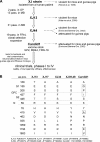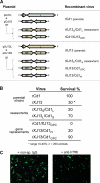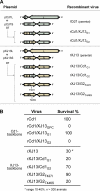The major determinant of attenuation in mice of the Candid1 vaccine for Argentine hemorrhagic fever is located in the G2 glycoprotein transmembrane domain
- PMID: 21795336
- PMCID: PMC3196416
- DOI: 10.1128/JVI.00856-11
The major determinant of attenuation in mice of the Candid1 vaccine for Argentine hemorrhagic fever is located in the G2 glycoprotein transmembrane domain
Abstract
Candid1, a live-attenuated Junin virus vaccine strain, was developed during the early 1980s to control Argentine hemorrhagic fever, a severe and frequently fatal human disease. Six amino acid substitutions were found to be unique to this vaccine strain, and their role in virulence attenuation in mice was analyzed using a series of recombinant viruses. Our results indicate that Candid1 is attenuated in mice through a single amino acid substitution in the transmembrane domain of the G2 glycoprotein. This work provides insight into the molecular mechanisms of attenuation of the only arenavirus vaccine currently available.
Figures




References
MeSH terms
Substances
Associated data
- Actions
LinkOut - more resources
Full Text Sources

